Crafting the Ideal Atlantic Salmon Dish
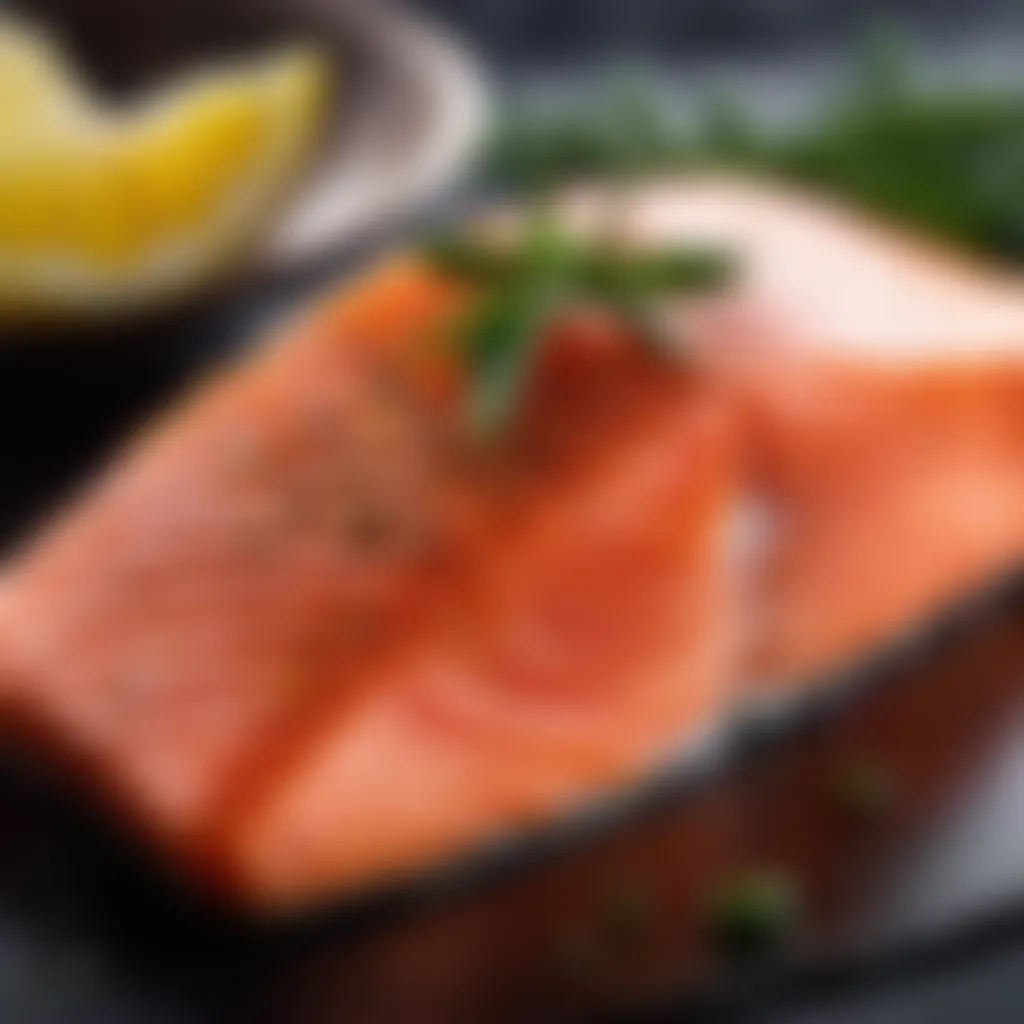
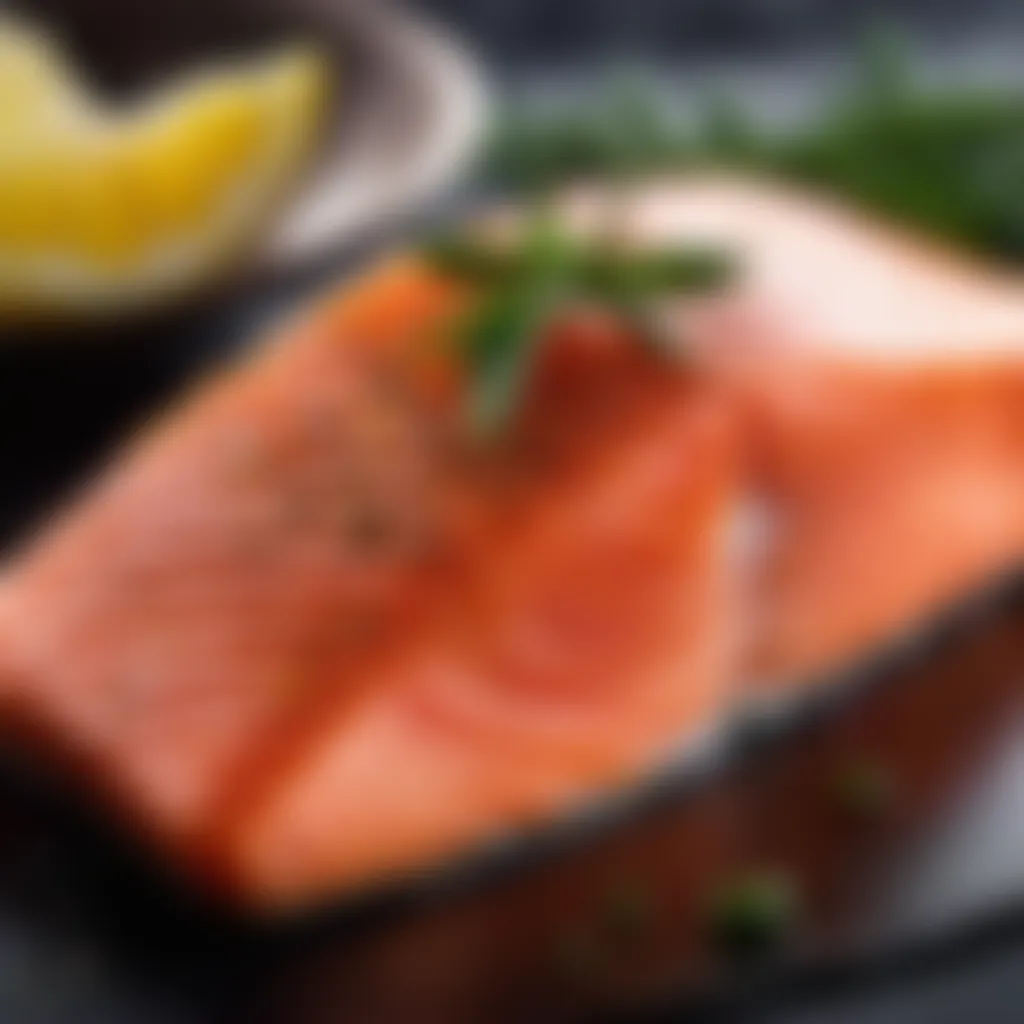
Intro
Atlantic salmon is a true staple in the world of cooking, cherished not just for its delightful flavor, but also for its versatility in different cuisines. This fish, with its rich, buttery texture, takes on various cooking methods and pairs beautifully with an array of ingredients. Whether you sauté it, grill it, or bake it, Atlantic salmon has a knack for bringing joy to the dinner table. In this guide, we will unravel the secrets to cooking the perfect Atlantic salmon, diving deep into ingredient selection, preparation, cooking processes, and presentation.
Ingredients:
Before venturing into the culinary journey, it's crucial to gather the right ingredients. Below is a precise list, ensuring you have everything needed for a delicious Atlantic salmon dish:
- Atlantic salmon fillets - 2 pieces (about 6 ounces each)
- Olive oil - 2 tablespoons
- Garlic - 2 cloves, minced
- Lemon juice - from 1 lemon
- Fresh dill - 2 tablespoons, chopped
- Salt - 1 teaspoon (to taste)
- Black pepper - 1/2 teaspoon (to taste)
- Honey - 1 tablespoon (for glaze)
- Vegetables for sautéing (e.g., asparagus, bell peppers) - about 2 cups
- Optional for garnish: lemon slices and additional dill
Preparation Steps:
Detailed Instructions:
- Starting Point: Begin by ensuring that the salmon fillets are thawed if they were frozen. Pat them dry with a paper towel
- Mix the Marinade: In a small bowl, combine olive oil, minced garlic, lemon juice, chopped dill, salt, and black pepper. This aromatic marinade will infuse the fish with flavorful goodness.
- Marinate the Salmon: Place the salmon fillets in a shallow dish or a resealable plastic bag. Pour the marinade over the salmon, ensuring each piece is coated evenly. Let the fish marinate for at least 15 minutes to absorb the flavors.
Technical Aspects:
Finding the right cooking temperature and time is key for perfectly cooked salmon. Here's what you need to know:
- Oven Temperature: Preheat your oven to 375°F (190°C) if baking or medium-high heat if grilling.
- Cooking Time: Salmon typically needs about 15-20 minutes in the oven, or 6-8 minutes per side on the grill, depending on thickness.
Cooking Process:
Sequential Steps:
- Cooking the Salmon (Baking Method): Place marinated salmon fillets on a lined baking sheet. Bake in the preheated oven for 15-20 minutes until it flakes easily with a fork.
- Grilling Method: Alternatively, heat your grill and lightly oil the grates. Grill the salmon skin-side down for 6-8 minutes per side. If desired, brush the fish with honey during the last few minutes to create a glossy glaze.
- Vegetable Pairing: While the salmon cooks, sauté your choice of vegetables in a skillet with a bit of olive oil and remaining minced garlic for about 5-7 minutes until tender and vibrant.
Troubleshooting Tips:
Sometimes things don’t go according to plan. Here are some common issues and their fixes:
- Dry Salmon: If the salmon turns out a bit dry, try reducing cooking time next time and check its doneness sooner. A little underdone is better than overdone!
- Not Flaking: If the salmon doesn't flake easily, it may require a bit more time. Covering with foil can also help retain moisture if needed.
- Flavorless: If it tastes bland, consider letting it marinate longer or adding more seasoning to the marinade.
By following these steps, you’ll be on your way to crafting a delectable Atlantic salmon dish that will surely delight anyone lucky enough to share your table.
Foreword to Atlantic Salmon
The journey into the world of Atlantic salmon begins with understanding not just what it is, but why this particular fish holds such an esteemed spot in culinary culture. When delving into the intricacies of preparing Atlantic salmon, one cannot overlook its significance not just as a dish but as a staple ingredient in many kitchens. It stands out not only for its taste but also for the nutritional value it brings to the table. This introduction serves as a foundation for exploring the identity of Atlantic salmon, its culinary stature, and its essential role in meals prepared across the globe.
Understanding Atlantic Salmon
To truly appreciate Atlantic salmon, one must understand its biological and ecological background. Native to the northern Atlantic Ocean, this fish thrives in both the wild and aquaculture settings. Its rich, pink-red flesh, attributed to its diet rich in krill and algae, is more than just pleasing to the eye; it speaks to its nutritional prowess. More often than not, those vibrant hues suggest the presence of essential nutrients like omega-3 fatty acids, known to support heart health.
Furthermore, Atlantic salmon displays an undeniable adaptability to farmed conditions, leading to a consistent supply that meets global demand. Whether wild-caught or farm-raised, it's critical for people to recognize how these sources can influence both taste and sustainability. Engaging with the characteristics specific to Atlantic salmon can help consumers make informed decisions about their choices in sourcing.
Culinary Importance
Atlantic salmon occupies a revered position in culinary practices around the world. This fish is incredibly versatile, serving as the centerpiece in various dishes ranging from grilled fillets to rich, creamy pastas. Its tender, buttery texture, when expertly prepared, can turn an ordinary meal into an exquisite dining experience. The flavor of Atlantic salmon carries a uniqueness that pairs well with numerous ingredients, allowing for endless culinary creativity.
Moreover, the fish’s rich nutritional content cannot be overlooked. A serving of Atlantic salmon is packed with proteins and necessary fatty acids, essential for maintaining good health. Featuring it in one’s cooking not only satisfies taste buds but also provides numerous health benefits – a wisdom even home cooks pass down across generations.
"Cooking with high-quality ingredients leads to great meals. Atlantic salmon is one of those ingredients that elevates your dish effortlessly."
In summary, understanding Atlantic salmon lays the groundwork for recognizing its culinary significance. The unique flavor profile, combined with health benefits, frames a narrative that invites cooks, whether novice or seasoned, to embrace this remarkable fish in their culinary ventures.
Choosing the Right Atlantic Salmon
When it comes to crafting a scrumptious dish with Atlantic salmon, selecting the right fish isn't just a ritual; it lays the groundwork for the entire culinary experience. The importance of this selection process cannot be overstated. The league of flavors and the texture of your final dish depend heavily on the quality and type of salmon you begin with. It's similar to constructing a house; if the foundation is shaky, the rest can crumble down. Understanding how to discern fresh from frozen and sourcing quality fish are crucial steps in ensuring your culinary endeavor is successful.
Fresh vs. Frozen
In today’s fast-paced world, the choice between fresh and frozen fish often comes up. Fresh salmon, with its translucent pink hue and firm texture, is generally considered the gold standard. It should feel firm to the touch, and you should notice a clean ocean smell. Here’s why fresh salmon deserves a closer look:
- Texture and Flavor: Fresh Atlantic salmon has a tender, buttery texture and rich flavor that frozen just cannot fully replicate. The moisture and fat retention is far superior.
- Nutritional Value: Fresh fish retains more of its vitamins and minerals, offering you and your family a healthier meal.
On the flip side, frozen salmon can be a blessing. When properly flash-frozen, it can be just as nutritious as fresh. Moreover, it allows you to keep salmon on hand for last-minute meals without worrying about spoilage. Here are a few pointers if you’re considering frozen salmon:
- Look for flash-frozen options: This ensures the fish was frozen at its peak freshness.
- Check for packaging: Avoid any that are torn or damaged, as they may lead to freezer burn.
- Thaw or not: If you plan to grill or bake, cooking straight from frozen can yield excellent results. Just adjust the cooking time accordingly.
Sourcing Quality Fish
Finding high-quality Atlantic salmon takes a bit of legwork, but it’s totally worth the effort. Not all salmon are equal, and quality varies depending on the source. Here are some strategies to consider when sourcing your fish:
- Local Fish Markets: Visit a trusted fishmonger who knows their products well. Ask about their sourcing practices; a knowledgeable seller will gladly share details about where the fish comes from.
- Look for Certifications: If you're buying packaged salmon, check for certifications. Labels like "MSC Certified" or "Sustainable Seafood" can guide you toward more responsible choices.
- Seasonal Sourcing: Be aware of when is the best time to buy salmon. Typically, the wild-caught season runs from spring to fall, while farmed salmon is available year-round. In-season fish can mean fresher options.
- Read Reviews: Trustworthy and informed suppliers usually have online presence on platforms like Reddit. User reviews can give insights into consistent quality and tastes.
- Community Supported Fisheries (CSFs): These programs allow you to buy directly from local fishermen. Not only are you supporting your community, but you ensure the fish’s journey from sea to plate is as short and as fresh as possible.

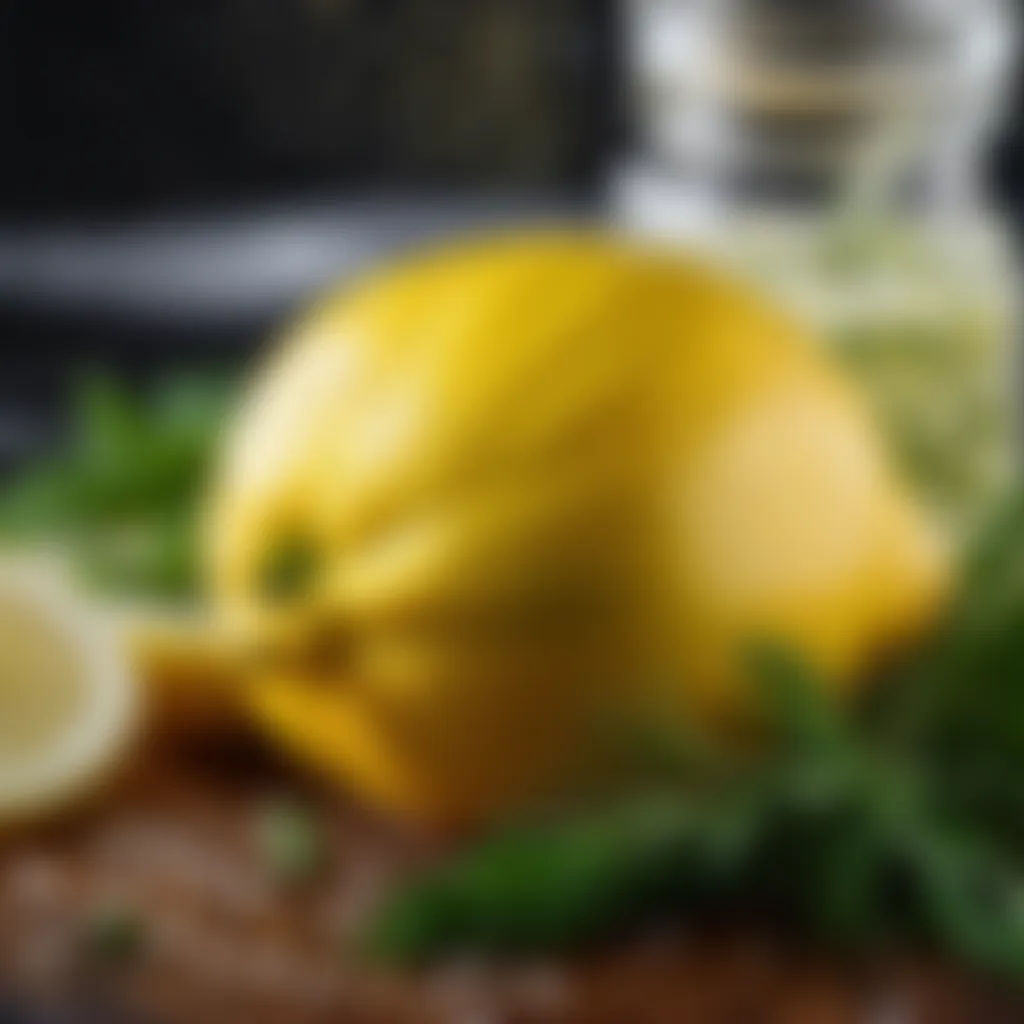
Quality sourcing isn’t just about better flavor; it’s about making choices that invest in your health and the planet.
With these insights into selecting the right Atlantic salmon, you’re setting yourself up for success in the kitchen. Next, we'll dive into essential preparation techniques that will complement this choice.
Essential Preparation Techniques
Essential preparation techniques are crucial when it comes to Atlantic salmon, as they not only influence the taste but also the texture of the fish. Properly preparing the salmon sets the stage for an enjoyable dining experience. Whether you're a seasoned cook or just stepping into the culinary world, understanding these techniques can elevate your dish.
Cleaning and Filleting
When you buy fresh salmon, you ideally want to make sure it's clean. Cleaning involves removing any scales, blood, and entrails, which can impart an unpleasant taste if not properly addressed. Start with cold water to ensure the fish is easy to handle. You should use a sharp, flexible filleting knife for the job.
To fillet the salmon, cut behind the gills and down to the backbone, following the natural curve of the rib cage. Then, glide the knife above the bones to separate the flesh from the skin. This technique may take a bit of practice, but in time you’ll be able to do it like a pro. A clean fillet not only looks appealing but also absorbs marinades and flavors better, which is vital for taste.
Marinating Options
Marinating salmon is a fantastic way to enhance its flavor profile. It allows the fish to soak up various seasonings, fostering a better overall taste. There are two main types of marinades you can explore: simple and complex.
Simple Marinades
Simple marinades often rely on just a few ingredients—think olive oil, lemon juice, and a sprinkle of salt. This approach is popular because it doesn't overshadow the natural flavor of salmon but rather enhances it.
Key characteristics of simple marinades include:
- Ease of preparation: Just mix the ingredients and let the fish soak for about 30 minutes.
- Balance of flavors: They allow the fish's richness to come through while adding a fresh note through acidity.
One potential disadvantage is that these marinades do not provide the depth of flavors that a more complex mix would. However, for those who prefer a straightforward approach, this can be quite beneficial.
Complex Flavor Profiles
Complex flavor profiles delve deeper into taste, introducing ingredients like soy sauce, honey, garlic, and various spices. These combinations work together to create a more intricate flavor experience that can complement the rich, buttery taste of the salmon.
Key characteristics of complex marinades include:
- Richness in flavor: The layers of different ingredients can yield a more satisfying finish.
- Versatility: They can be tailored to suit various cuisines, whether you want Asian-inspired, Mediterranean flair, or even a smoky barbecue element.
However, the unique feature of complex marinades is the time required for absorption, often best left overnight. Choose wisely, as the intense flavors may clash with certain methods of cooking or other accompanying dishes.
In the end, whether you opt for simple marinades or complex flavors, both contribute significantly to the overall experience of cooking and enjoying Atlantic salmon.
Cooking Methods for Salmon
Cooking methods play a crucial role in enhancing the flavors and textures of Atlantic salmon. Each technique brings out different characteristics of this fish, allowing for a range of culinary experiences. Whether you prefer the smoky char from grilling or the rich, moist texture achieved through poaching, understanding various methods is key. In this section, we will explore how different cooking methods not only influence taste but also affect the nutritional profile of the salmon. This knowledge empowers home cooks to create dishes that not only please the palate but also maintain the health benefits attributed to this fish.
Grilling Techniques
Grilling is a time-honored method that infuses salmon with a distinctive smoky aroma. When you grill, high heat creates a beautiful char on the surface while locking in moisture. It’s vital to preheat your grill to ensure an even cook. Flipping the fish only once helps to keep it intact. If you’re using skin-on fillets, grilling skin-side down is advised to prevent sticking. A good tip is to oil the grill grates before placing the fish to ease the removal process.
Baking Considerations
Baking salmon is an excellent approach if you seek consistency in doneness. This method allows for gentle cooking, which keeps the fish flaky and moist.
Optimal Baking Temperatures
When baking salmon, a temperature of 375°F to 400°F is generally recommended. At this range, you achieve a perfectly cooked piece without drying it out. A higher temperature can lead to a crispy exterior, yet there’s a fine line where fish becomes overcooked. The beneficial aspect here is that baking is straightforward; you can add toppings or marinades which get infused during the cooking time, enhancing flavor profiles.
- Key characteristic: At this range, cooking is even, preventing the dreaded dryness.
- Unique feature: Enhances versatility by allowing for different flavors through toppings.
- Advantages: Baking allows for a set-it-and-forget-it approach, which is perfect for busy cooks.
Cooking Times
Cooking times are essential for getting salmon just right. Typically, fillets need about 15-20 minutes in the oven, depending on thickness. It’s crucial to check the salmon’s internal temperature, aiming for about 145°F for optimal texture.
- Key characteristic: Time varies with thickness, requiring an attentive cook.
- Beneficial choice: Offers a greater margin for error compared to other methods.
- Unique feature: It’s easy to pair with sides in the same oven, creating a completed meal.
Poaching Process
Poaching is gentle and preserves moisture and flavor effectively. By cooking salmon in a simmering liquid—such as broth, wine, or even citrus juice—you prevent the loss of delicate tastes. Typically, about 10-15 minutes will do depending on the fillet thickness. This technique is perfect if you want to serve the salmon cold on salads or as a delicate main course. It’s an underrated technique but one that reveals a subtle flavor without being overly assertive.
Sautéing Approaches
Sautéing is a quick method that gives you great control over the cooking process. Using high heat and a bit of oil allows you to crisp the exterior while leaving the inside tender. The process can be done in about 6-8 minutes, making it ideal for weeknight dinners. You might even consider adding vegetables to the pan, which can absorb some of the salmon's flavors while cooking, making it a one-pan wonder.
"The method you choose not only defines the meal but also showcases the versatility that Atlantic salmon provides."
Understanding these cooking methods can greatly enhance your ability to create delightful salmon dishes that suit various preferences. Enjoy the experimenting in your kitchen!
Flavor Pairings with Atlantic Salmon
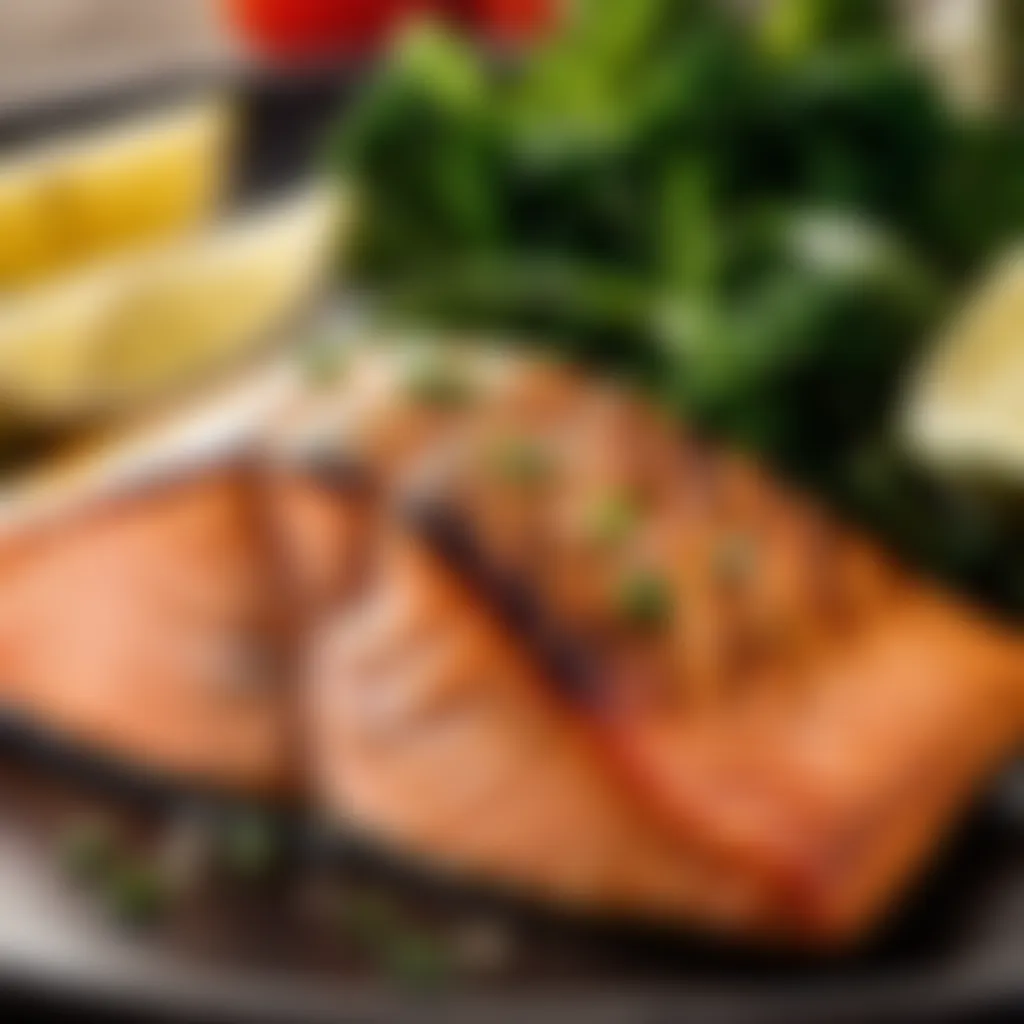
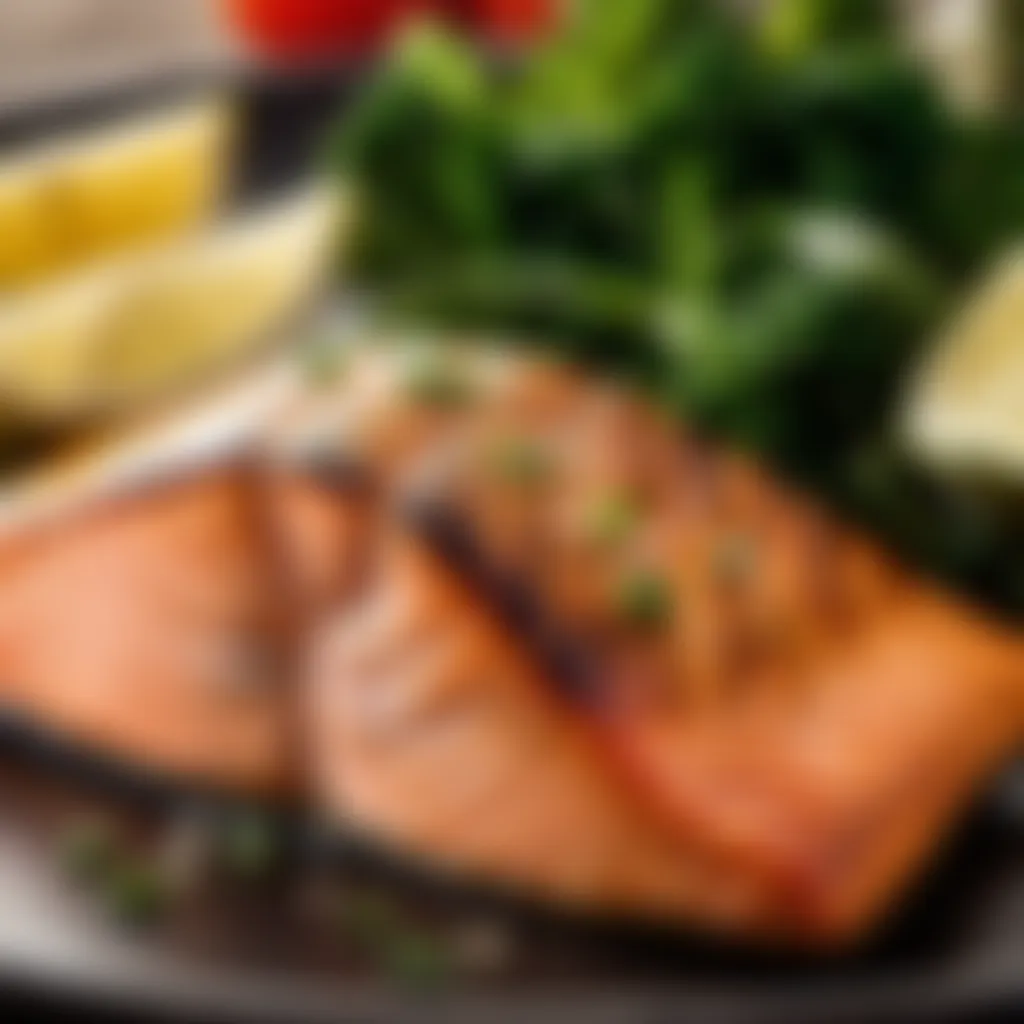
Flavor pairings are the not-so-secret ingredients that elevate a dish from ordinary to extraordinary. In the case of Atlantic salmon, which boasts a rich, buttery texture and a subtle flavor, understanding what complements it can be the key to culinary success. Utilizing specific elements that enhance the fish's natural taste not only brings depth to the dish but also creates balance on the plate. Furthermore, savvy pairings can help in creating a memorable meal that resonates with family and friends, making dining a more enjoyable experience.
Herbs and Spices
When it comes to seasoning Atlantic salmon, the right herbs and spices can transform a simple meal into a gourmet experience. Fresh dill and tarragon are classic choices that bring a hint of brightness. These herbs have a unique scent that dances about the kitchen when cooking, enhancing the overall olfactory pleasure of the dish.
For a bolder approach, consider using smoked paprika or cumin. Smoked paprika adds a layer of depth with its subtle heat, while cumin offers an earthy note that harmonizes beautifully with the fish's flavor.
Consider the following herbs and spices:
- Dill: Brightens up the flavor.
- Tarragon: Adds an aromatic dimension.
- Chili Powder: For a dash of heat.
- Garlic: Because, well, garlic makes everything better!
"Pairing the right herbs can make your salmon not just a dish, but an experience."
The important thing to remember is to use these botanicals judiciously. Too much can overpower the delicate salmon flavor. A sprinkle here, a dash there might just do the trick.
Citrus Elements
Citrus fruits provide a refreshing contrast to the richness of salmon. They cut through the oily texture and brighten up the palate. The zest and juice of lemons, limes, or oranges can be your best friend when preparing this dish.
- Lemon Zest: Adds a tangy, invigorating burst.
- Lime Juice: A zesty touch that pairs nicely with grilled salmon.
- Mandarin Segments: For a sweet surprise and visual appeal on the plate.
Using citrus not only adds flavor but also helps in tenderizing the fish if marinated prior to cooking. The acid from citrus fruits can break down the proteins, allowing the salmon to soak in the flavors more effectively.
Vegetable Complementation
Pairing salmon with the right vegetables can create a symphony of flavors on your plate. Think of vegetables that are not only nutritious but also enhance the overall taste and aesthetic of your dish.
Leafy greens, seasonal vegetables, or even root vegetables can offer both texture and flavor contrasts.
- Asparagus: Its earthy qualities balance salmon nicely.
- Spinach: Wilted spinach topped on salmon adds color and nutrition.
- Carrots: Roasted carrots can provide a sweet note and a crunchy texture.
- Zucchini: Grilled zucchini brings a delicious smoky element.
These complementary vegetables can be prepared in a multitude of ways—roasted, grilled, or even pickled. Their flavors can accentuate the natural taste of the salmon, ensuring you are not just filling up plates, but crafting a meal that highlights each ingredient.
By thoughtfully combining herbs, citrus, and vegetables, one can unlock a variety of flavor profiles that will elevate the dining experience and showcase the versatility of Atlantic salmon.
Plating and Presentation Techniques
Plating and presentation are the cherry on top when it comes to serving Atlantic salmon. It's not just about what hits the palate; it's about what catches the eye, too. A beautifully presented dish can elevate a simple meal to a fine dining experience. Integrating the right techniques in plating can also enhance the overall dining experience and create a sense of excitement and anticipation. An appealing assembly brings out the flavors in surprising ways and makes every bite more enjoyable.
Visual Appeal
Creating a stunning visual presentation is integral to enjoying a meal. Here are some tips to pack a powerful visual punch:
- Color Coordination: Consider the color palette of your ingredients. The rich pink-orange of the salmon can beautifully contrast against vibrant greens from herbs or sautéed vegetables. Pair these with splashes of yellow or red from citrus or tomatoes to really make your plate pop.
- Plate Choice: The dish you choose plays a significant role. Clean white plates create a beautiful canvas for your food, letting the colors stand out. Alternatively, dark plates can add sophistication and drama, making the dish appear even more luxurious.
- Layering Foods: Think about the heights and dimensions of your meal. Stacking ingredients can create visual interest and guide the eye around the plate. For example, place your salmon fillet atop a bed of sautéed spinach, then scatter some cherry tomatoes around.
- Negative Space: Don't overcrowd your plate. Empty spaces give an airy feel and let the eye rest. It invites diners to appreciate each element individually. A well-placed garnish or side can draw focus, creating an enticing focal point.
"In presentation, as in life, it’s the little touches that count. A sprinkle of herbs, a dash of color – they tell a story on the plate."
Garnishing Suggestions
Garnishing is where creativity can really shine. Simple yet effective garnishes can dramatically elevate your dish:
- Fresh Herbs: Use herbs like dill, parsley, or basil to sprinkle over your salmon. Not only do they add color, but also a burst of fresh aroma and flavor.
- Zest and Slices: Citrus zest or thin slices of lemon or lime can brighten up the dish and give a hint of acidity that balances the richness of the fish.
- Edible Flowers: For a touch of elegance, consider edible flowers. They can bring an unexpected whimsy and add sophistication without overwhelming the taste.
- Sauce Swirls: A drizzle of sauce—whether it's a balsamic reduction or a lemon butter sauce—can make for a stunning display. Use a spoon to create playful swirls on the plate, adding both flavor and elegance.
Incorporating these plating and garnishing techniques not only prepares your dish for eyes but also enhances the experience of savoring the Atlantic salmon. The meal becomes a feast for all senses, encouraging everyone to enjoy not just the flavors, but the artistry involved in every bite.
Nutritional Benefits of Atlantic Salmon
Understanding the nutritional landscape of Atlantic salmon is paramount when embarking on a culinary journey centered around this exquisitely tender fish. It’s more than just a delightful addition to your plate; it embodies a treasure trove of health benefits. For the discerning housewife looking to balance flavor with nutrition, knowing what Atlantic salmon brings to the table can transform mealtime into a nourishing family experience.
Omega-3 Fatty Acids
One of the standout features of Atlantic salmon is its richness in omega-3 fatty acids, particularly EPA and DHA. These essential fats are known for their myriad of health benefits. They contribute significantly to heart health by reducing triglycerides and lowering blood pressure. Plus, they can help manage cholesterol levels, reducing the risk of heart disease. But that’s just the tip of the iceberg.
"Omega-3 fatty acids are crucial, not just for heart health, but also improve brain function and mood stability."
In addition to cardiovascular benefits, omega-3s play a vital role in cognitive function. Studies suggest a link between these fatty acids and improved memory and mood regulation. This makes incorporating Atlantic salmon into your family’s diet not only a culinary delight but also a proactive measure for mental well-being.
Furthermore, omega-3s have anti-inflammatory properties, which may help alleviate conditions like arthritis and promote joint health. So, if you’re seeking a way to enhance your family's meal while keeping those pesky joint aches at bay, this fish might just be your best friend in the kitchen.
Vitamins and Minerals
In the realm of vitamins, Atlantic salmon doesn’t fall short. It is a fantastic source of vitamin D, which plays a crucial role in bone health and immune function. Just a serving can help you meet your daily requirements, especially in areas where sunlight is less available for parts of the year. Notably, vitamin D is also implicated in supporting mental health, making this fish a double whammy for your well-being.
Moreover, Atlantic salmon packs quite a punch with B vitamins. Vitamin B12, in particular, supports energy production and neurological function. For busy housewives juggling different tasks, this energy boost from a delicious salmon dish can be incredibly beneficial.
When it comes to minerals, you’ll find a healthy dose of selenium and potassium. Selenium acts as an antioxidant, helping your body fend off oxidative stress. On the other hand, potassium aids in maintaining healthy blood pressure levels, allowing your family to benefit from yet another layer of heart health.
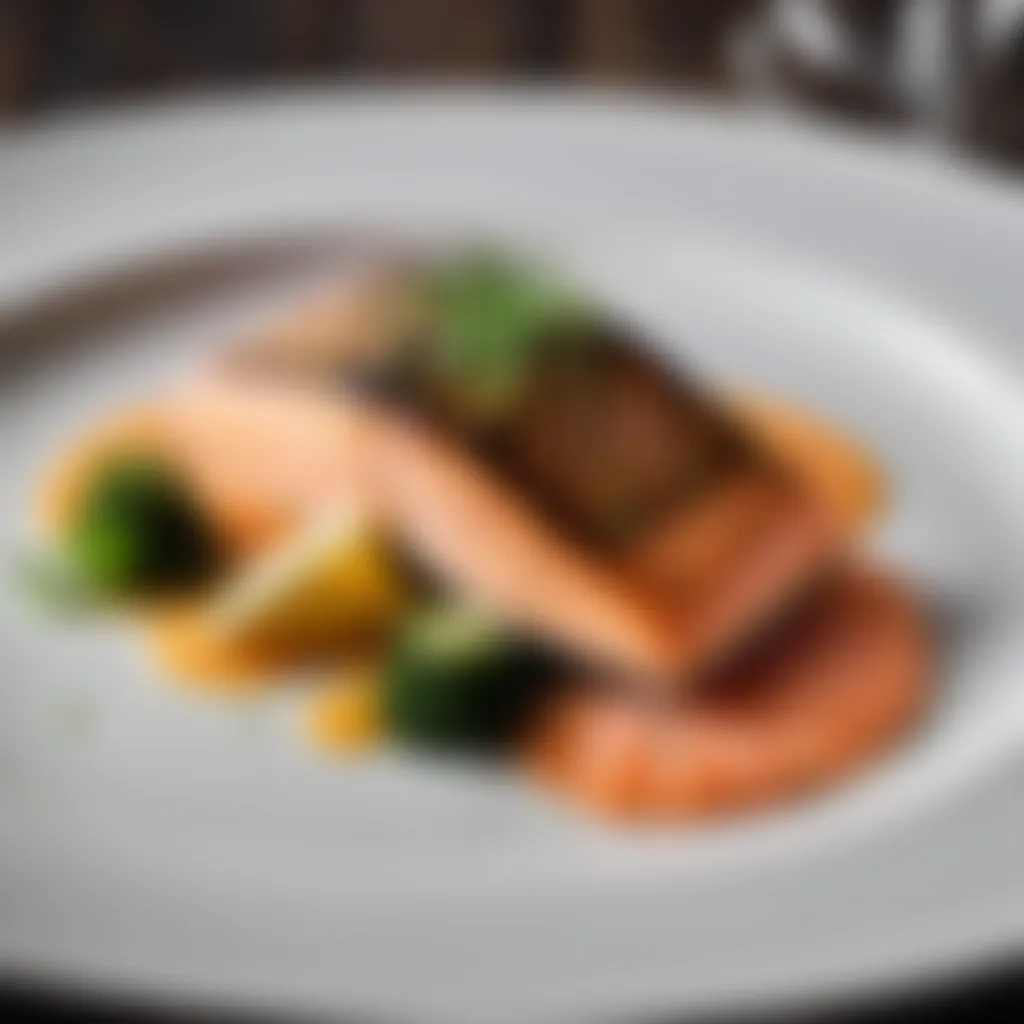
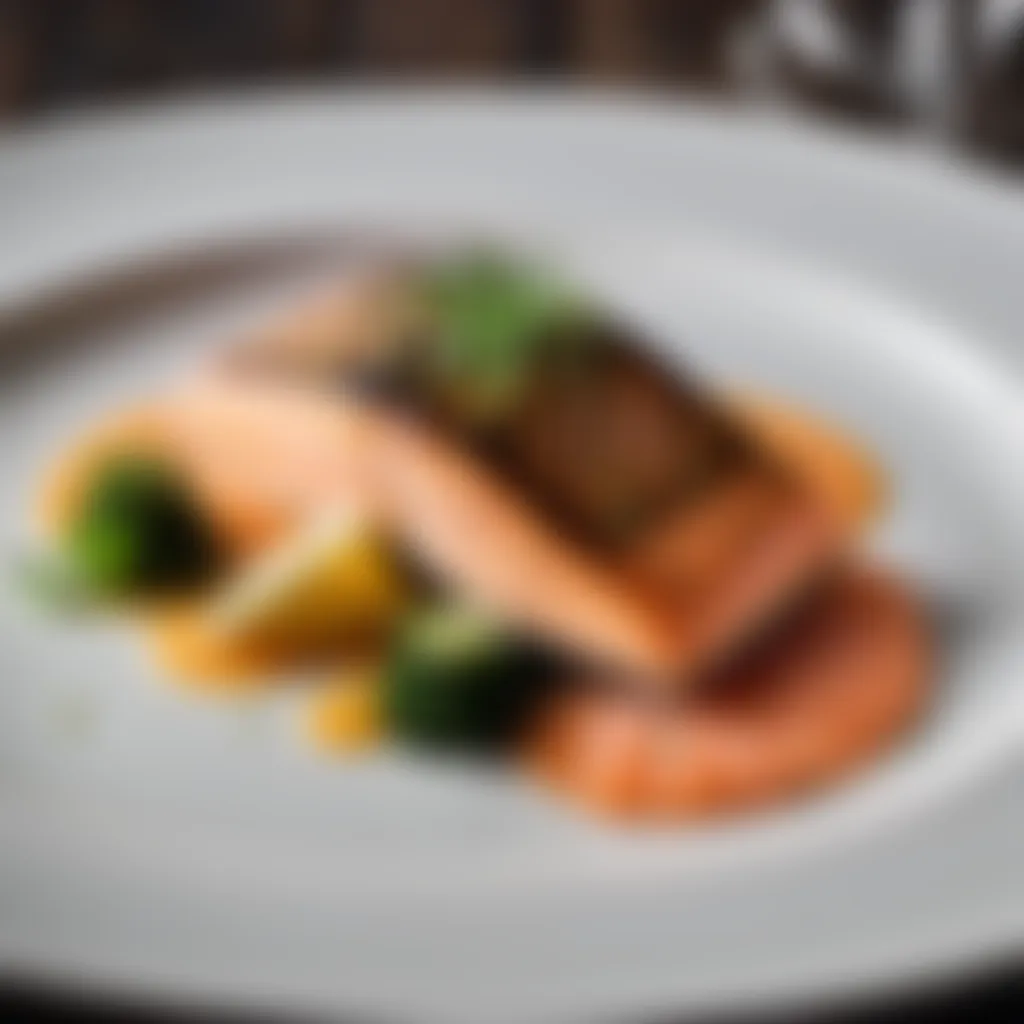
In summary, the array of nutritional benefits offered by Atlantic salmon is extensive. From omega-3 fatty acids to a rich supply of essential vitamins and minerals, it truly is an ingredient that combines delight with health. By understanding these benefits, you can craft meals that nourish both the body and soul, reinforcing the culinary magic that can happen in your kitchen.
Regional Variations in Recipes
When it comes to cooking Atlantic salmon, the geographical context can weave an extraordinary tapestry of flavors and techniques. Regional variations in recipes matter significantly; they enrich our culinary landscape and illuminate how local ingredients, traditions, and cultures shape our dishes. Understanding these variations not only enhances the enjoyment of the meal but also gives insight into the lives of those who prepare it.
Nordic Influences
Nordic cuisine has a longstanding relationship with seafood, particularly salmon. Countries such as Norway and Sweden have traditions that bring forth the fresh, briny flavors of the ocean, creating unique dishes that showcase the fish.
One method that stands out is gravadlax, a Nordic delicacy where the salmon is cured with a mix of sugar, salt, and dill. This infusion allows the fish's natural richness to shine while offering a balance of sweet and herbaceous notes. It’s usually served thinly sliced, perfectly paired with a mustard sauce and crisp rye bread.
Another popular dish is smoked salmon, which often features a dry-brine method, allowing the fish to absorb smoke while retaining moisture. The result is an incredibly tender fish with a complex flavor profile. This method highlights the importance of traditional smoking techniques, often using local woods such as juniper or birch to enhance the aroma.
Avoiding the ordinary, Nordic recipes focus on preserving the salmon, granting a taste experience that's both novel and steeped in history.
This cultural emphasis on freshness, preservation, and presentation reveals much about life in the North and their respect for the seasonal ebb and flow of ingredients.
Mediterranean Flavors
Transitioning to the Mediterranean perspective, the approach to Atlantic salmon shifts significantly. In regions like Italy and Spain, seafood is often complemented with vibrant and fresh ingredients. Dishes here tend to celebrate garlic, olive oil, and fresh herbs, transforming the salmon into an aromatic centerpiece.
For instance, consider a classic Mediterranean preparation of salmon with tomatoes, olives, and capers. This dish highlights the importance of acidity and umami, where ripe tomatoes bring sweetness, olives add brininess, and capers provide a tangy kick. Roasting the salmon with these ingredients not only allows the flavors to mingle but creates a sauce that can be spooned over grains like couscous or quinoa, making it a hearty meal.
Another representation is the herbed salmon en papillote, where the fish is baked in parchment paper with assorted vegetables, fresh basil, and lemon. This method allows for steaming the fish, preserving moisture while also allowing for the infusion of flavors from the herbs and other ingredients. The result is a dish that feels light yet sumptuous, perfect for a spring or summer dinner.
As we can see, the Mediterranean variations highlight a journey of flavors that pivot around freshness, simplicity, and balance, contrasting beautifully with the heartiness of Nordic preparations. Each regional recipe provides home cooks with inspiration and techniques, emphasizing the versatility of Atlantic salmon as a canvas for a variety of tastes and traditions.
Sustainability and Ethical Sourcing
Understanding the sustainability and ethical sourcing of Atlantic salmon is vital not only for conscious consumers but also for the health of our planet. As the popularity of this fish rises, the impact of sourcing methods on ecosystems and local economies becomes a significant consideration. Choosing sustainably harvested salmon means making a personal commitment to environmental responsibility, benefiting cleaner oceans and healthier fish populations.
Wild-Caught vs. Farm-Raised
When deciding between wild-caught and farm-raised Atlantic salmon, several factors come into play that influence nutritional value, taste, and environmental impact.
Wild-Caught:
Wild-caught salmon is generally considered superior in taste and nutritional quality. These fish swim in their natural habitat, feeding on a diet rich in natural prey. This diet contributes to a more intense flavor and leaner texture. However, the availability of wild salmon fluctuates due to overfishing and environmental changes, which can put pressure on stocks.
Farm-Raised:
Farm-raised salmon offers a more consistent supply, typically at a lower price point. However, these fish are often raised in crowded conditions, which can lead to the spread of diseases. Moreover, the use of antibiotics and artificial coloring agents can affect both health and taste. Many farms are now adopting sustainable practices, such as reducing feed conversion ratio and minimizing environmental footprint. These advances can mitigate some negative impacts associated with traditional aquaculture, making farm-raised options more appealing in ethical sourcing discussions.
Choosing responsibly sourced salmon can help support fish populations and promote habitat preservation.
Impact on Ecosystems
The ecological implications of salmon farming and fishing methods are far-reaching. Poorly managed farms can lead to water pollution, habitat destruction, and an increase in parasites that affect wild fish stocks. Improper disposal of waste products and feed can release nutrients into waterways, causing algal blooms and disrupting local aquatic ecosystems.
On the flip side, sustainable practices emphasize the importance of protecting wild salmon populations through regulations and best practices. Understanding quotas, seasonal fishing, and habitat restoration projects are essential. Supporting fisheries that prioritize sustainability ensures a more balanced interaction with nature and promotes healthier ecosystems for future generations.
To contribute to sustainable practices, consumers can:
- Look for certifications from organizations like the Marine Stewardship Council.
- Choose brands that commit to sustainable methods.
- Stay informed about local regulations and efforts to improve salmon farming.
By educating themselves and actively participating in the process, consumers can play a pivotal role in encouraging sustainable practices in the salmon industry.
End: Mastering Atlantic Salmon
As we draw this culinary journey to a close, it’s time to reflect on the various elements that come together to create the perfect Atlantic salmon dish. Mastering salmon is not just about the final plate; it’s about understanding the entire process, from selection to execution.
When it comes to preparation, think of it as a canvas awaiting your artistry. Selecting the right fish can set the stage for a great meal, as the freshness and quality speak volumes in flavor. Your choice between wild-caught versus farm-raised salmon can have implications not only for taste but also for sustainability. Being well-informed on these aspects empowers you to make choices aligning with your values while ensuring your dish shines.
Cooking methods play a pivotal role. Whether you prefer grilling, poaching, or baking, each technique offers its own unique flavor and texture. The beauty of salmon lies in its versatility—each method brings forth different qualities, allowing you to tailor your approach to suit any occasion or palate.
Moreover, flavor pairings elevate a simple dish into an extraordinary experience. By incorporating fresh herbs, vibrant citrus, and complementary vegetables, you create layers of complexity that make each bite unforgettable. The effort put into choosing these accompaniments adds depth to your meal, making it not only a feast for the stomach but also for the eyes.
Finally, presentation is the cherry on top of all your hard work. A well-plated salmon dish radiates attention to detail and consideration, making it all the more delightful. With garnishes that accentuate your dish, you’ll leave a lasting impression on those fortunate enough to share in your culinary achievements.
Mastering Atlantic salmon opens up a world of exploration in your cooking journey. With the right techniques and a dash of creativity, you can transform this rich, flavorful fish into stunning meals that nourish the body and soul.
Final Thoughts on Preparation
As you prepare to take on your kitchen endeavors, remember that preparation is as crucial as the cooking itself. From cleaning to filleting, learning how to handle salmon properly sets the foundation for a successful dish. Each step is an opportunity to enhance your skills.
It’s also vital to not shy away from experimentation. Feel free to adjust marinade recipes to cater to your taste; a hint more garlic, a splash less soy sauce, or even trying out new herbs can alter the profile significantly.
"Cooking should be personal; it’s a reflection of you. Pop your own twist on those classic recipes!"
Encouragement for Experimentation
The kitchen is not a place solely for following recipes to the letter. Rather, it is a space for creativity and spontaneity. Each dish is a chance to play with flavors and techniques. Don't be afraid to deviate from the norm. Mixing up your marinade with unexpected ingredients turns the ordinary into extraordinary. For instance, consider swapping traditional dill for fresh tarragon; the result may surprise you!
When it comes to sides, think outside the box. Instead of the usual steamed broccoli, try roasting brussels sprouts with balsamic reduction. The caramelization will work wonders in complementing the salmon's inherent richness.
Try inviting friends or family to join in your kitchen adventures. Getting their feedback can spark new ideas and inspire different combinations. If something doesn’t go as planned, don’t fret—each misstep is a learning moment. Embrace it; you don’t just make meals, you create memories.
Ultimately, mastering Atlantic salmon isn’t merely about following a set of steps but reveling in the process of discovery. With practice, patience, and a sprinkle of courage, you will find your rhythm in the kitchen and produce dishes that you and your loved ones will savor.







